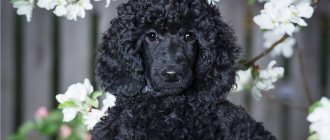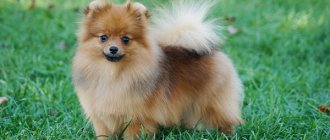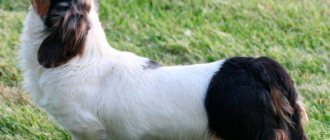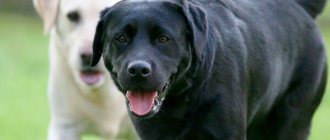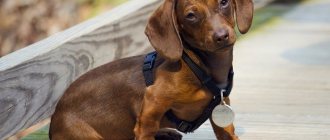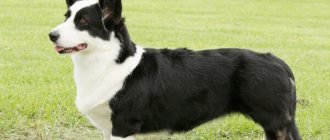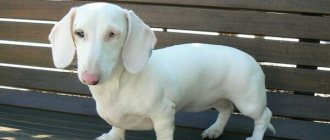The red color of dachshunds is one of the most popular. It is almost as widespread as the black and tan, which is considered the most classic of the breed.
And this is not surprising, because a bright red dachshund always looks impressive and positive.
A pet of this color will not let its owners get bored; next to it it will always be warm and sunny, like on a clear summer day.
However, like all other dogs, red dachshunds have their own breed characteristics.
Origin story
The history of red dachshunds is lost in ancient times. After all, back in Ancient Egypt, dachshund dogs with an elongated body and short legs were bred and used for hunting.
Germany is considered the homeland of dachshunds, where these dogs have long been used for hunting small burrowing game. At the same time, the first reliable information about them dates back to approximately the beginning of the 18th century, although, according to some sources, dachshunds were encountered already in the 15th century.
Considering that at that time hunters bred mainly dogs with excellent working qualities and spent less time on the exterior, it can be assumed that the ancient German dachshunds were distinguished by a large variety of colors. And, undoubtedly, among them there were many red animals.
NOTE!
The first dachshunds, bred in Germany, were longer-legged and less stocky, but their heads and muzzles already had the shape characteristic of modern dogs.
Elongated ears and a long, but strong tail are the result of selection associated with their hunting use.
Hanging ears covering the ear canal prevented soil, plant seeds and other foreign objects from entering it while digging a hole. A long, but not too thin tail was necessary so that the hunter could see the dog from a distance in the tall grass, and if the dachshund got stuck in a hole, he could grab onto it and help it get out.
Purpose
Dachshunds are hunting dogs designed to hunt foxes and hares, as well as burrow-dwelling beavers, badgers and otters. Among hunting dogs, dachshunds are the smallest, but the most courageous and confident. Since ancient times, many hunters are satisfied with the choice of the smartest breed of dachshund dog. Climbing into a hole, the dachshund fights in a dark and narrow hole, relying only on itself, knowing that the owner will not be able to help. It is also common for dachshunds to hold prey in a hole until the owner opens the hole.
Marriage or breed?
The red color is considered the standard and one of the classic coat color options for dogs of this breed.
Expert opinion
Kozhevin Semyon Kirillovich
Expert dog handler.
Red color of varying brightness and intensity is very common in dachshunds. Along with black and tan and brown and tan, this is one of the most classic colors. Depending on whether the dog has black hairs or not, it can look either bright golden-red or almost brown. But at the same time, the red shade of the coat should never be lightened to fawn or, especially, cream. The presence of unevenly colored hairs turns this color into sable or boar.
Defective colors
Cream
Puppies of this color are currently born only to long-haired dachshunds. Outwardly it looks like pale red, and sometimes almost white, but with an inconspicuous tea or yellowish tint. The color is not recognized as acceptable.
Black brindle with tan
This variety is black and tan. It differs from the color variant recognized by the RKF in that it is not a single-color tan with the presence of stripes or brindles on them. Recognized by tribal marriage.
Isabella
Very light chocolate tone or coffee with milk. Isabella dachshunds are distinguished by weak immunity and a bunch of genetic problems accumulated by the family branch. Such puppies are born from the mating of brown and blue parents and are very rare.
White
White dog, pink nose (black or brown, for example). The eyes can have black or brown eyeliner, and the lips can be lined. The iris of the eyes is necessarily brown. This color is categorically not allowed by the standard, especially in the case of albinism, as it is combined with serious genetic health problems. An albino dachshund can be easily distinguished from a true white one by the color of its eyes: albinos are characterized by lightish pupils, and the iris of the eye can be pale blue or reddish.
Double merle
The second name is double marble. Carriers of this color have rather problematic health. Puppies of this color can be born if both parents have a merle color. It differs from classic marble in the presence of white color. The eyes are often blue. Heterochromia occurs. Particularly big problems arise with weakened colors - Isabella or blue. These colors are associated with severely weakened immunity, and congenital deafness and blindness are common. It is considered a serious marriage.
Advantages and disadvantages
Pros:
- Smart and intellectual.
- Sociable and friendly pets.
- They love to play.
- Dachshunds have very funny and incredibly rich facial expressions.
- They can become good friends for children.
- They are energetic and, despite their small size, physically resilient.
- With proper maintenance and care they can live a long time.
- The dachshund is an excellent hunter of small burrowing animals.
- Dachshunds make good guards for a house or apartment.
Minuses:
- Diseases of the musculoskeletal system and spine may develop.
- Prone to obesity and overeating.
- Quite cocky towards other people's dogs.
- They can be stubborn and disobedient at times.
- They will not miss the opportunity to rummage in the ground.
Training
Dachshund training begins as early as possible. Some rules that will help raise a dachshund:
- Before showing what to do, you must say a command.
- Don't distract your dog while executing the command.
- Do not give the treat until the dog has completed the command.
- Always pronounce commands in the same tone and clearly formulated.
Before teaching a dog commands, it is necessary to formulate principles of education, such as:
- Teach the dog its name.
- Train him to use a collar and leash.
- Toilet and outdoor training.
- Get used to your absence.
Dimensions, weight and other features
There are three size varieties of dogs of this breed:
- Standard . The chest girth is from 35 cm. Such individuals weigh approximately 9 kg.
- Miniature . Chest volume - from 30 to 35 cm, weight - 4-5.5 kg.
- Rabbit . Chest circumference up to 30 cm, weight - from 3.4 to 4 kg.
The red dachshund is a short, but at the same time quite strong and strong dog with well-developed muscles. She doesn't look funny or disproportionate.
A characteristic feature of dachshunds is a highly elongated body and short, but at the same time quite strong legs. Elongated, high-set ears hanging along the cheekbones and a long, but not too thin tail are also characteristic breed characteristics of these dogs.
The head is wedge-shaped, without a pronounced transition from the forehead to the muzzle. The mouth is strong and deep, the teeth are strong and snow-white, always in full set and in a correct scissor bite.
The eyes of red dachshunds are not too large, but expressive. Set slightly askew, they can be any of the dark brown shades.
A black nose is preferred, but brown pigmentation of the earlobe is also acceptable.
Color - any shade of red or reddish-fawn. There may be an admixture of black hair, but no blackening of the hairs.
IMPORTANT!
A small white spot on the chest is not considered a fault. But if the dog has white ears, this is no longer considered a standard.
Photos of varieties by coat type
In addition to size, red dachshunds are divided into three types, differing in the quality and texture of their coat:
- Smooth-haired . The coat is quite soft, short, lying close to the body.
- Long-haired . The coat varies in length: on the head and muzzle it is the same as that of smooth dachshunds: very short and close-fitting. On the ears, paws and body the hair is longer, quite soft and silky. At the same time, the hair of a long-haired dachshund should be thick enough so that the dog’s skin does not show through it.
- Wirehaired . Thick and coarse hair, similar to that of terriers, forming hair on the face in the form of mustaches, beards and eyebrows.
A dachshund of any of the above types can be either a standard or a reduced variety.
Price
The price of a rabbit dachshund depends on its variety. Individuals of a single color with smooth fur are in particular demand among hunters. This species has a submissive character and is distinguished by a lightning-fast reaction to the owner’s commands.
On average, the cost of pets ranges from 10 to 25,000. The price of a dog is calculated based on its pedigree. Titled individuals are distinguished by their intelligence, ability to quickly learn and devotion.
Life expectancy and health
The average life expectancy of dachshunds is 12-13 years. But with good heredity and quality care, representatives of this breed can live up to 15 or even 17 years.
Most dachshunds are in good health and rarely get sick, but some of the representatives of this breed may be prone to diseases such as:
- Chest deformity.
- Slipped disc syndrome.
- Eye pathologies.
- Retinal atrophy.
- Epilepsy.
- Obesity.
CAREFULLY!
It should be remembered that dachshunds are especially susceptible to spinal injuries, so you need to carefully monitor your pet so that it does not fall or jump from a height.
Vaccinations
Disputes about vaccination schedules and the benefits of this or that vaccine practically do not subside.
The most commonly used scheme can be identified: the puppy is vaccinated for the first time at 2 months with Nobivak DHPi+LEPTO, Eurican or Duramun (whichever is closer).
The second injection is given 2 or 3 weeks later - strictly with the same vaccine.
The third vaccination - a complex one, containing a vaccine against rabies - is done after the dog has replaced all its teeth, that is, not earlier than 6-7 months.
The next immunization is carried out after 12 months, and then every year at approximately the same time.
Little gardeners look after house plants
Basic care rules
Long-haired and smooth-haired red dachshunds require regular brushing. During the shedding period, you can use a furminator or a special brush to remove dead hair from shedding dogs.
Dachshunds with long hair may also need a little cosmetic trimming, such as removing hair between their toes and trimming ear hairs. The purpose of this manipulation is not only to give a more well-groomed appearance, but also to take care of the comfort of the pet itself.
Wire-haired dogs need trimming from time to time. If you wish, you can learn this art, but if the dog is a show dog, then it is better to do it with a professional groomer or in a pet salon.
Dachshunds are bathed infrequently, but only when their fur becomes dirty. And also, if necessary, clean eyes, ears and teeth.
Red dachshunds' nails are trimmed when they begin to grow too long and bend downward. In this case, only the part of the claw that has turned down is removed with a nail cutter.
How to choose a puppy?
Nowadays, it is not difficult to purchase a red dachshund. Minor difficulties may arise only when searching for a long-haired rabbit or miniature dachshund.
But in any case, you need to remember that only buying a puppy in a nursery or from a breeder recommended by the club can guarantee that the pet is a dachshund, and not a mestizo or mongrel.
It is very important to carefully consider the choice of nursery or breeder, as well as the line from which the future pet comes. Even before purchasing it, you need to try to find out as much as possible about its parents; also, if this is not the first litter from this couple, it would be nice to look at their already grown puppies.
When choosing a baby dachshund, you need to pay attention to the fact that he looks strong and well-fed.
IMPORTANT!
Some dishonest breeders deliberately underfeed standard puppies in order to pass them off as miniature or rabbit dachshunds.
These babies grow less well and are more susceptible to infections, so you need to be especially careful when buying a puppy of a smaller variety of this breed.
It is also very important to check how the puppy hears and how freely it moves, since stiffness in movements may be evidence of problems with the spine or deformation of the chest.
A good dachshund puppy is interested in people and does not show aggression or fear towards its littermates or adult kennel dogs.
Personality of the Miniature Dachshund
Representatives of the miniature variety are distinguished from standard dachshunds not only by their size, but also by their more explosive temperament. Although the breed was never bred for hunting in Russia, the working talents of the “dwarfs” have not atrophied, so they continue to use them wherever the opportunity arises. As an example: miniature dachshunds have a heightened protective instinct, which they do not hesitate to “turn on” several times a day.
If the pet urgently needs a release, and there is no suitable threat nearby, the brave short-legged one will invent an enemy for himself, whom he will immediately bark loudly. During walks, dwarf dachshunds remember their historical purpose and willingly poke their noses into every hole. It is also a matter of honor for the breed to terrorize frogs, rodents and chicks that come their way, so do not regard such attacks as obstinacy and bad manners of the animal. Miniature dachshunds can't do it any other way.
In their youth, many representatives of the breed are guilty of destructive behavior. Basically, bursts of negative activity are typical for individuals who take little and unproductive walks and are often forced to remain alone, so if your dachshund has started “renovating” the apartment and is removing wallpaper from the walls, there is reason to think about it. It is quite possible that it is not the pet that is to blame for this mess, but his reclusive lifestyle and your own laziness. As the animal grows older, its internal battery begins to operate in energy saving mode. Take such changes calmly: the dog still won’t turn into a couch potato, it will just turn on the “alarm” a little less often.
Speaking of sofas: dwarf dachshunds are not averse to lying on them, but the breed likes games and active pastime more. The cunning “sausages” also establish contact with children one or two times, but with one caveat: the younger generation should not demonstrate their own superiority over the pet. In their hearts, most dwarf dachshunds consider themselves equal to their owner, leaving a lower level of the hierarchical ladder for the rest of the family. Don’t forget that all representatives of the breed are great artists when it comes to any benefits for them. Dachshunds who have received a scolding from their owner love to give their faces a mournful expression and press for pity. By begging for an extraordinary walk or a tasty treat, the dog also demonstrates miracles of cunning and ingenuity, which inexperienced owners often “buy in.”
